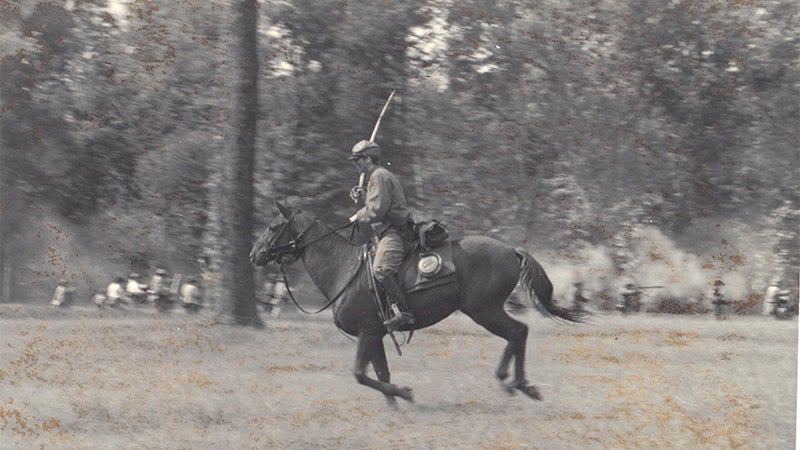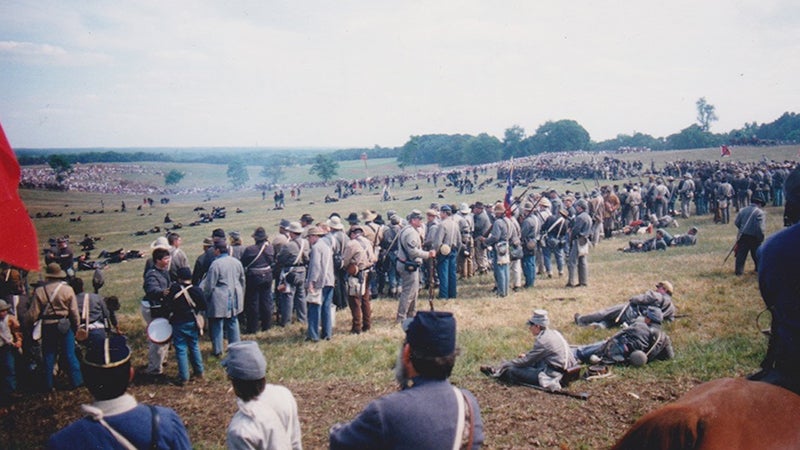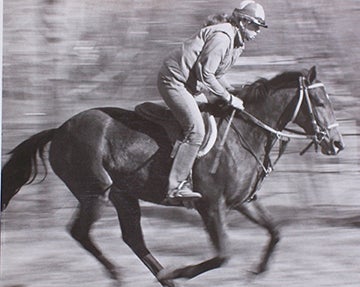Adventures on Horseback: The most fun I’ve ever had on a horse
Published 8:00 am Wednesday, April 4, 2018

- Catherine Hunter on her thoroughbred, Count of War, race across a field while canons thunder in the background. (Photo submitted by Catherine Hunter)
I was a Civil War cavalry reenactor for more than 20 years.
Not because I was really into the war, or believed the “South was going to rise again,” or anything so political. I did it because it was fun.
A lot of people have asked, in horror, how I could “glorify” war. It was because I was a reenactor that I went on a peace ride to New York.
Playing a wounded soldier and seeing an illustration of the destruction and waste helped me realize that, while I wanted to advocate for peace, I also reenacted to honor those who sacrifice for our country.
While reenacting was a lot of fun, it was also a lot of work. Not only do you have to have a horse that is steady to all that noise and chaos, you have to have all the right equipment.
A reenactor can’t go to an event in a Western or an English saddle. You even have to have the right type of halter, lead rope and buckets.
I really enjoyed camping out, 1860s style.
It’s amazing how destressing spending three days away from modern lights and sounds can be. There’s something magical about sitting around a campfire or looking out over the camp lit by the glow of lanterns and listening to music with the rhythm of another age.
Authentic period camping also meant no sleeping bags, raincoats or radios. Coolers had to be hidden in a wooden box, and we slept on blankets on the ground.
Another challenge for the women who want to do more than sit in camp and darn socks or have tea is they have to look like soldiers. Male soldiers.
History has actually documented more than 400 women who disguised themselves as men to fight in the war. There is no way of knowing how many actually fought and were never discovered. So, I would spend an extra hour in the mornings before colors putting on makeup and hiding the obvious under my uniform.
Perhaps one of the things I enjoyed about reenacting was being able to hone my riding skills. Not only did Count and I get to charge across fields at a gallop, spin and wheel and race off in a different direction, we drilled with the unit.
Reenacting allowed us to actually use dressage training for the purpose it was invented. We practiced the precision of obliques, wheels, holding 4–foot intervals and galloping in line. It’s amazing how in the heat of battle, with one hand holding a pistol or sabre, that training comes through, and Count would listen to my legs signaling him, to a shift of weight or lift of a rein.
I often hear people talk about horses being “bomb proof,” and think of the cannons going off while Count would stand so quietly I could drop the reins on his neck and take pictures. Reenacting was not only fun, it was a great training tool.
After braving cannons, smoke, waving flags, drums, charging soldiers, bugles, campfires and saber fights, there wasn’t much in the mundane world that bothered Count. I think he enjoyed the reenactments about as much as I did, though probably for vastly different reasons.
Another part of reenacting that was really fun were the evening dances. I would trade my uniform for a six-bone hoop skirt, do up my hair and dance to the Virginia Reel by torchlight.
After the dance we would spend hours sitting around the campfires telling stories, reciting poetry or singing the old songs. Count would be nearby on the picket line and I could hear him munching hay throughout the night from my tent. Talk about bonding with your horse.
One of my most memorable moments in reenacting was at a small event in east Tennessee. It was Sunday, and I was riding Confederate that day. The North was chosen to win that day.
All the other Confederate cavalry troopers had taken hits or had tack problems and had to withdraw from the field. It was near the end of the battle and I was the last Confederate mounted that day.
I looked up and saw the color bearer running up a hill with four blue-coated soldiers chasing him.
“Give me the colors!” I shouted. The kid heard me, stopped and held out the flagpole. Count leaped forward and we flew by, grabbing the flag at a dead run.
The Yankee soldiers fell quickly behind as Count raced up the hill. At the crest we stopped and turned back to look over the field. The wind picked up the white flag with the red St. Andrews Cross in the corner and it rippled in the breeze.
Oh yeah. This is why I reenact.
Catherine Hunter’s journalism career spans 20 years of writing for newspapers and magazines, including The Chronicle of the Horse, The Western Horseman, he Tryon Daily Bulletin and Foothills Magazine. In 2000, Hunter received a South Carolina Press Association award for reporting in depth. She is the author of “Sacred Connections Horsemanship: Empowering Horse and Rider through Chakra Energy.” Email her at catherine.hunter@tryondailybulletin.com.



